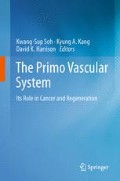Abstract
Primo vessels have been found on various organs of the animals. The liquid in these vessels reveals distinct chemical compositions according to a proteomic analysis. A recent study showed the primo vessels to be functioning pathways of cancer metastasis. In this article, we report evidence of tissue healing in the liver via a primo vessel. In the hope that a sudden impact of irreversible electroporation (IRE) on liver tissue could provide a dynamic response by the primo vessel, we employed it to induce apoptosis in ablated lesions, which yielded positive signals in H&E staining and on a TUNEL assay. The ablated regions were observed to draw primo vessels in order to cure the damage. The primo vessels were observed with a Trypan blue technique. In addition, capillaries were observed to have been structurally preserved after applying IRE while another study showed extensive hepatocellular regeneration in the post-IRE stage. These results suggest that the PV appears to contribute to curing the ablated lesions in the liver.
Access this chapter
Tax calculation will be finalised at checkout
Purchases are for personal use only
References
Kim BH (1965) The Kyungrak system. J Jo Sun Med 108:1–38 [Korean]
Shin HS, Johng HM, Baik KY et al (2005) Feulgen reaction study of novel threadlike structures (Bonghan ducts) on the surfaces of mammalian organs. Anat Rec B New Anat 284:35–40
Sung B, Kim MS, Kim YJ et al (2008) Measurement of flow speed in the channels of novel threadlike structures on the surfaces of mammalian organs. Naturwissenschaften 95:117–124
Lee BC, Kim KW, Soh KS (2009) Visualizing the network of Bonghan ducts in the omentum and peritoneum by using Trypan blue. J Acupunct Meridian Stud 2:66–70
Lee BC, Baik KY, Sung B et al (2004) Acridine orange staining method to reveal the characteristic features of an intravascular threadlike structure. Anat Rec B New Anat 278:27–30
Lee BC, Yoo JS, Soh KS et al (2008) Development of a fluorescence stereomicroscope and observation of Bong-Han corpuscles inside blood vessels. Indian J Exp Biol 46:330–335
Lee BC, Yoo JS, Soh KS et al (2005) Novel threadlike structures (Bonghan ducts) inside lymphatic vessels of rabbits visualized with a Janus Green B staining method. Anat Rec B New Anat 286:1–7
Lee BC, Soh KS (2008) Contrast-enhancing optical method to observe a Bonghan duct floating inside a lymphatic vessel of a rabbit. Lymphology 41:178–185
Shin HS, Johng HM, Lee BC et al (2005) Feulgen reaction study of novel threadlike structures on the surface of rabbit livers. Anat Rec 284:35–40
Chen EI, Hewel J, Krueger JS et al (2007) Adaptation of energy metabolism in breast cancer brain metastasis. Cancer Res 67:1472–1486
Lian Z, Wang L, Yamaga S et al (2002) Genomic and proteomic analysis of the myeloid differentiation program. Blood 98:513–524
Forte G, Carotenuto F, Pagliari F et al (2006) Hepatocyte growth factor effects on mesenchymal stem cells: proliferation, migration, and differentiation. Stem Cells 24:23–33
Wuchter P, Boda-Heggemann J, Straub BK et al (2007) Processus and recessus adhaerentes: giant adherens cell junction systems connect and attract human mesenchymal stem cells. Cell Tissue Res 328:499–514
Yoo JS, Kim HB, Soh KS (2009) Bonghan ducts as possible pathways for cancer metastasis. J Acupunct Meridian Stud 2:118–123
Neal RE, Garcia PA, Rossmeisl JH et al (2010) A study using irreversible electroporation to treat large, irregular tumors in a canine patient. Conf Proc IEEE Eng Med Biol Soc 1:2747–2750
Pech M, Janitzky A, Wendler JJ et al (2010) Irreversible electroporation of renal cell carcinoma: a first-in-man phase I clinical study. Cardiovasc Intervent Radiol 34:132–138
Charpentier KP, Wolf F, Noble LB et al (2010) Irreversible electroporation of the pancreas in swine: a pilot study. HPB (Oxford) 12(5):348–351
Maor E, Ivorra A, Leor J et al (2007) The effect of irreversible electroporation on blood vessels. Technol Cancer Res Treat 6(4):307–312
Zhang Y, Guo Y, Ragin AB et al (2010) MR imaging to assess immediate response to irreversible electroporation for targeted ablation of liver tissues: preclinical feasibility studies in a rodent model. Radiology 256(2):424–432
Al-Sakere B, André F, Bernat C et al (2007) Tumor ablation with irreversible electroporation. PLoS One 2(11):e1135
Rubinsky B, Onik G, Mikus P (2007) Irreversible electroporation: a new ablation modality-clinical implications. Technol Cancer Res Treat 6(1):37–48
Choi YS, Kim HB, Chung J et al (2010) Preclinical analysis of irreversible electroporation on rat liver tissues using a microfabricated electroporator. Tissue Eng Part C Methods 16(6):1245–1253
Han HJ, Ogay V, Pak SJ et al (2010) Primo-vessels as new flow paths for intratesticular injected dye in rats. J Acupunct Meridian Stud 3(2):81–88
Edward WL, Christopher LL, Stephen TK (2007) Imaging guided percutaneous irreversible electroporation: ultrasound and immunohistological correlation. Technol Cancer Res Treat 6(4):287–294
Author information
Authors and Affiliations
Corresponding author
Editor information
Editors and Affiliations
Rights and permissions
Copyright information
© 2012 Springer Science+Business Media, LLC
About this paper
Cite this paper
Kim, HB., Sung, CK., Ahn, S. (2012). Effect of the Primo Vascular System on Liver Tissue Recovery After Irreversible Electroporation: A Preliminary Study. In: Soh, KS., Kang, K., Harrison, D. (eds) The Primo Vascular System. Springer, New York, NY. https://doi.org/10.1007/978-1-4614-0601-3_16
Download citation
DOI: https://doi.org/10.1007/978-1-4614-0601-3_16
Published:
Publisher Name: Springer, New York, NY
Print ISBN: 978-1-4614-0600-6
Online ISBN: 978-1-4614-0601-3
eBook Packages: Biomedical and Life SciencesBiomedical and Life Sciences (R0)

